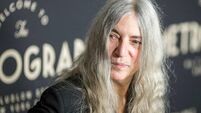Henry Glassie: An outsider's appreciation of Irish culture

Henry Glassie film from Pat Collins.
“Ireland’s glory is verbal”, says the celebrated folklorist Henry Glassie in a new documentary about his work. It was the Irish tradition for conversation and storytelling that brought him to the small Fermanagh town of Ballymenone in 1972, and he ended up living there for a number of years.
Glassie has made it his life’s mission to find and celebrate the art created by everyday people, be they rug makers in a remote Turkish village, potters and statue makers in Salvador, or Irish storytellers.
Now, Cork filmmaker Pat Collins has made a documentary about Glassie that shines a light on those artists. Glassie isn’t typically the central focus - and he wouldn’t have it any other way.
As he says in the film: “I don’t study people at all. I stand with them and study the things that they create.”
Collins, the award-winning filmmaker who brought us work including Song of Granite and Silence, first heard Glassie on Vincent Woods’ radio show Arts Tonight, and became intrigued by this charismatic man and his Irish connection.
“He was incredibly articulate and he was talking about his time in Fermanagh in the 70s,” recalls the Baltimore-based filmmaker. “I think it was the way he spoke about art. He spoke about how everyone had the potential to be an artist. It was a really democratic view of art and I think he broadened out what defines an artist, he was opening it up, that it’s not just a canvas that somebody paints.
"It chimed with my own experience of growing up among those who would be seen as people who weren't art people or people with an appreciation for art. But they love singing, and they love music, and they love dancing. He was making artists of everybody. I kind of shared that outlook.”
Still, Glassie wasn’t hugely enthusiastic about featuring in a documentary at first, which the seasoned filmmaker says can be a good thing.
“He didn't do email, so I had to write to him. And then he wrote back three months later, and then I wrote back to him. And we've gone like that for a couple years. Then he was in Dublin in 2016. I asked him about a documentary. And it just took a while to figure it out but eventually, he agreed to it.
“I wanted to make a documentary that chimes with the way he works. I feel like it's very collaborative. As opposed to making it about him, I was trying to make it almost from his viewpoint.”

The resulting film, Henry Glassie: Field Work, is beautiful and almost mediative, focusing as it does in the first forty minutes on the creators as they create and featuring little dialogue. It also sees Glassie return to the Fermanagh town he made his home decades earlier.
“The reason he came to Ireland first was because of Yates and Beckett and Joyce and Sean O'Casey. Those writers meant a lot to him and he wanted to come to this country that produced them. It was the English language that came out of Irish, and something new that came over in the way that Irish people expressed themselves,” says Collins.
“I think what he saw in Fermanagh was, a lot of people even though they told stories, they didn't call themselves storytellers. They were more historians in that they were telling stories from the past that were truthful and it was a way of sharing the history of the place. And the way we speak is quite different to a lot of other countries.”
Glassie was particularly interested in the area as The Troubles took hold, and walked the roads before deciding to stay in Ballymenone. “He lived in a caravan. He brought his wife and family over there and they lived there for maybe two years. He stayed longer and kept coming back and going back to America. Even within Ireland, I think, people were saying that there's not much history, or there's not much folklore in South Fermanagh. And I think that's why he also went there.”
Glassie has spent time in several other parts of the world, including Salvador in Brazil, where local artists are seen creating striking pieces of pottery and statues by hand. They also attend a Candomblé ceremony where local people dance in honour of the Gods. He has visited many times with wife Pravina Shukla, who is also a folklorist.
“We went seven hours into the countryside to a small pottery village. Salvador itself was fascinating, we got into all different kinds of houses and buildings that you wouldn't normally get into. A lot of the artists that we filmed, they're not well known at all. It was only because Henry had spent so much time there, they'll see a beautiful piece of work in a market. And then they'd actually do some detective work, and try to trace back who made it.”

The movie marks a return to the documentary format Collins cut his teeth in, before films like Song of Granite, the story of sean-nós singer Joe Heaney, and Silence became widely celebrated.
Born in Drimoleague and based in Baltimore, Collins didn’t initially think about the possibility of a filmmaking career and made his first documentary in his thirties. He took a deeper interest in film and culture when he moved to Cork city in his late teens.
But it was while living and working in Galway that he started to consider it as a career. During this time, he worked in the Galway Film Centre, edited a journal called Film West, and was programmer at the Galway Film Fleadh for three years.
He is currently developing a film about the writer John Millington Synge, based on his book The Aran Islands. “He went out there in 1898, went back there four or five times and wrote this beautiful book. We're hoping to maybe go into production the year after next.”
He has long felt that Glassie should be more celebrated outside folklorist circles. “I was always kind of surprised that he’s not on television in America. He has a vast knowledge of history and a vast knowledge of a huge amount of disciplines. He knew the Greenwich Village folk scene. He was there to meet Bob Dylan off the bus when he came in to New York from Minnesota. He was actually inside the recording studio when Bob Dylan was making his first album. He was very much involved in the whole civil rights movement.
“I think that he's really sincere about his mission. And his mission is to celebrate people who are not celebrated normally. Like the women who are making these amazing rugs up the side of a mountain in Turkey. The most amazing works of art, but they're not recognised, they're seen as being crafts. I think it implicates all of us really in a way, this very narrow view of what art is. That's his position, to celebrate that work that gets overlooked. It's not a sometime thing with him. It's a complete, lifelong mission.”
- Henry Glassie: Field Work is available from Friday, April 16, via such streaming services as IFI@HOME, Gate Cinemas online, Volta and QFT




